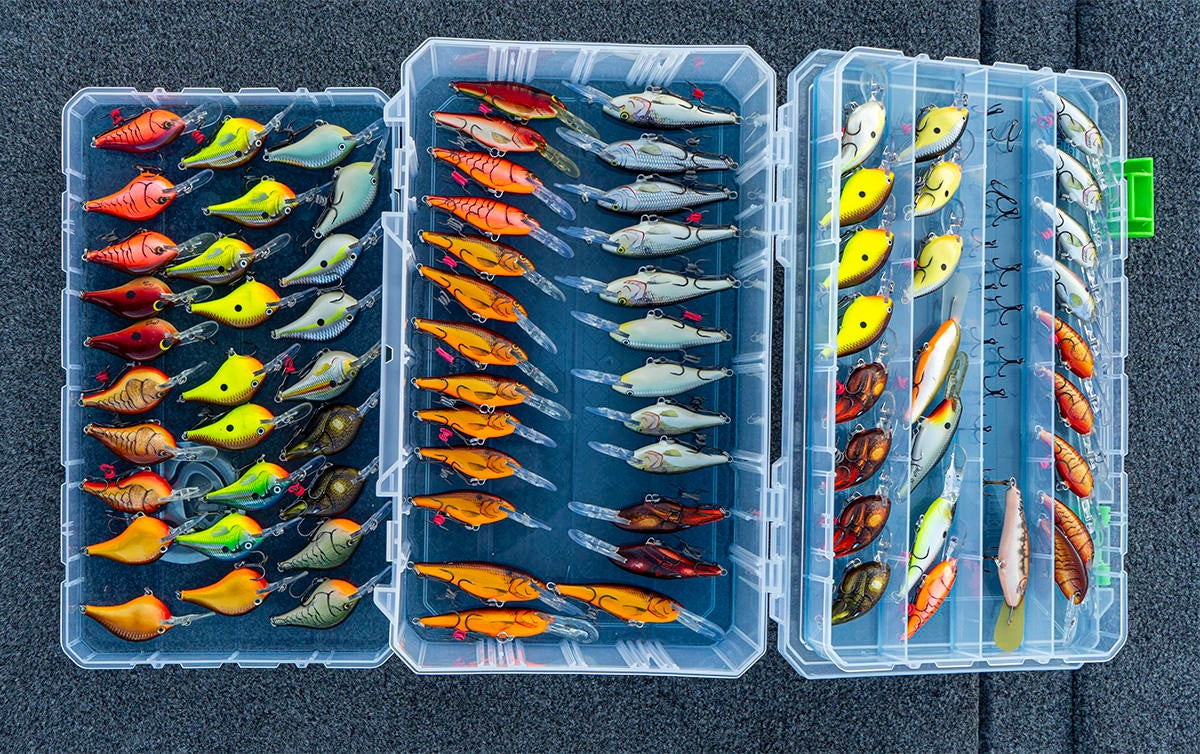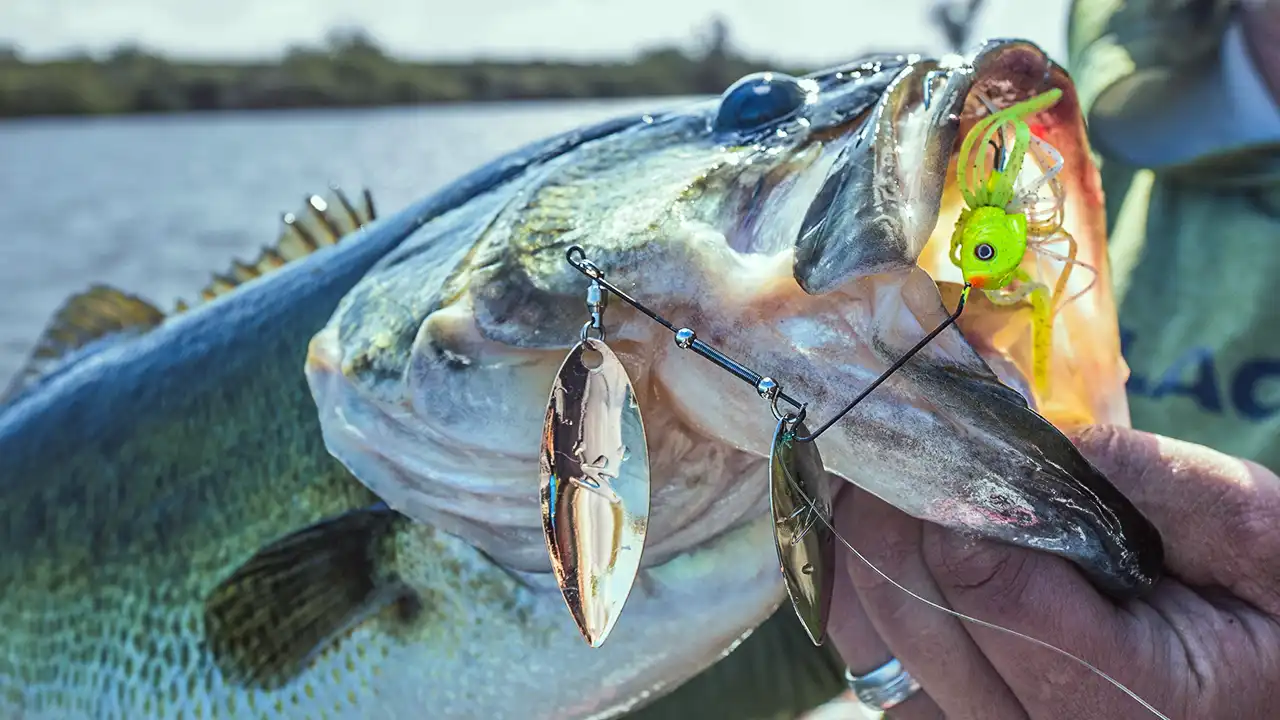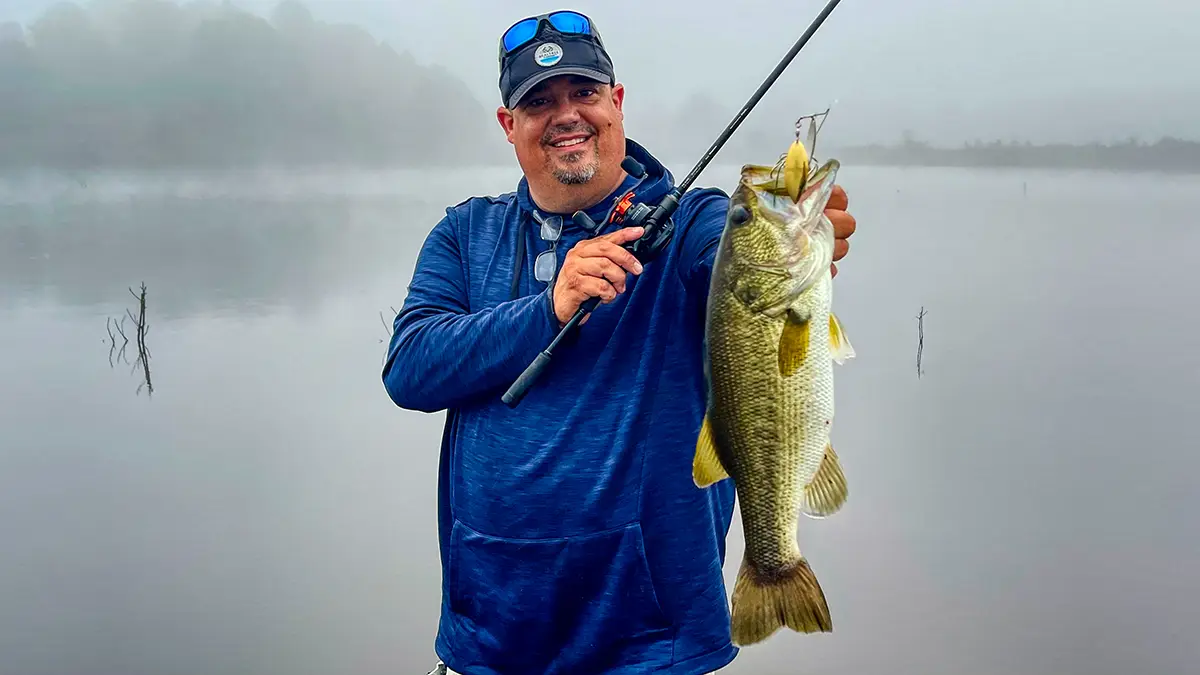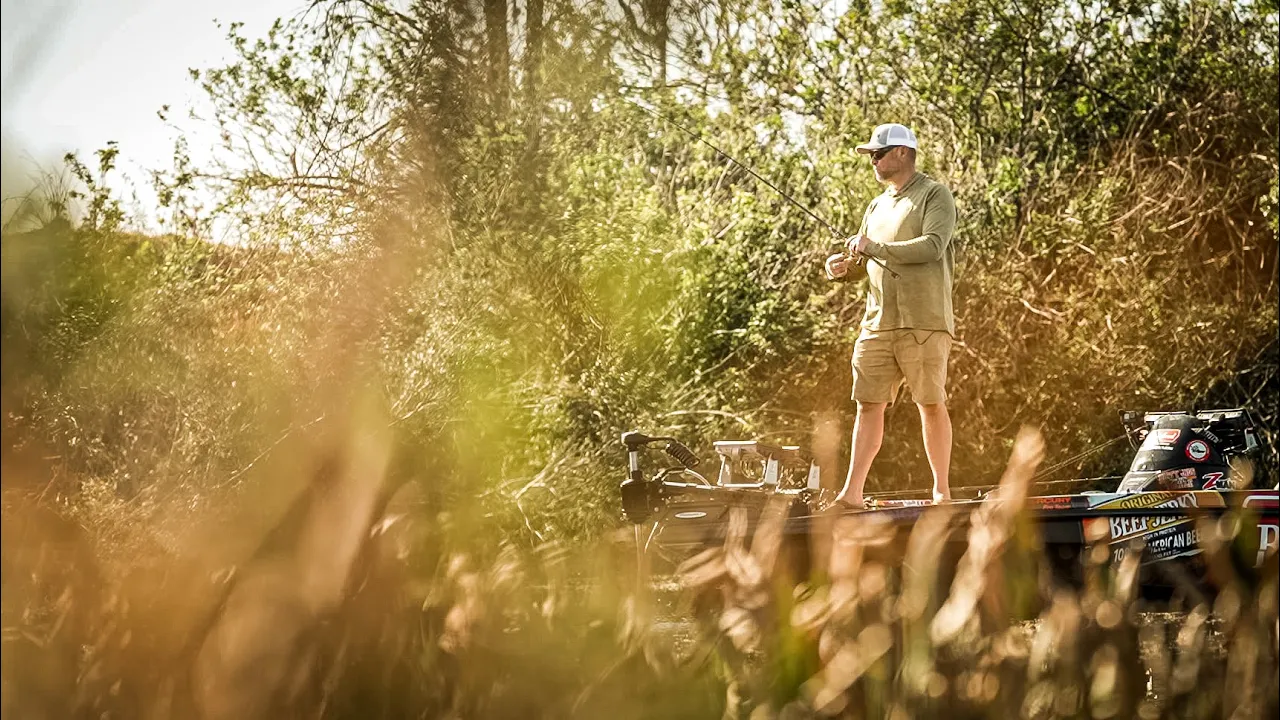A crankbait gets a bad rap in some circles of fishermen because it has so many hooks on it and it is automatically more prone to snag. But a crankbait, at times, can also be the most effective tool in your tackle box. It has the ability to trigger fish that a lot of other lures don’t posses. It has a wide range of sizes, colors, depths and actions that can make it a good choice in 2 feet of water when the water is cold and also in 25 feet of water when the water is warm. So learning how to fish a crankbait is well worth your time as a bass angler.
Truth be told, good crankbait anglers, catch a lot of bass, and a lot more big bass while having boxes and boxes of crankbaits in their tackle bag because they hardly ever lose any crankbaits. A hard-charging, wide-wobbling, deep-diving crankbait has long been known to stir up the biggest bass in a school. So there is often a time and place for the right crankbait in your bass fishing as well.

Bass Fishing Crankbait Categories
As mentioned, a wide variety of crankbaits makes choosing the right one for various fishing situations and bodies of water a little more challenging, but not as hard as one would think. In terms of choosing the right crankbait, it’s simply a matter of knowing what the different kinds do well and their intended use and applying them where it makes sense.
Crankbaits can basically be broken down into the following categories with some crossover:
- Square bills
- Finesse Shad Cranks
- Flat Side Cranks
- Medium Runners
- Deep Divers
- Lipless Cranks
You will find some finesse shad cranks are shallow crankbaits and some are medium diving crankbaits. And you will find some medium running crankbaits that are also flat sides. So some crossover between the categories of course happens.
Basically there are lipped crankbaits and lipless crankbaits and most lipped crankbaits will float when paused or suspend and slowly rise. Lipped crankbaits can be shallow, medium or deep diving in design. Using a deep diver in shallow water will not only wear you out more, but also get hung a lot more. So best to use shallow cranks in shallow water and deep cranks in deep water.
Your shallow crankbaits run from 0 to 5 feet. Your medium runners run from 5 to 10 feet and your deep divers run deeper than 10 feet. Square bills, flat sides and finesse shad crankbait for the most part are shallow runners while there are a few exceptions that get into that 5- to 9-foot range.
Flat sided crankbaits and finesse shad crankbaits tend to wiggle more than wobble. They have tighter actions, are not as snagless, but work really well at slow speeds and work really well in cold water.
Round bodied crankbaits, especially ones with square bills are much more snagless have wider wobbles and work better as the water warms up. The more buoyant they are, the easier they will come over wood and cover.
Medium divers will work from shallow water out to about 7-9 feet. They are great transition crankbaits when the bass are moving from deep to shallow or shallow to deep. These are great search baits and generally just really good all-purpose fish catchers. Especially when you’re not sure if the fish are shallow or just off the banks.
Deep diving crankbaits offer you a method for eliciting reactions from deep bass. They generally excel in triggering bigger bass out deep and also when bass are more competitive like when they gang up in the post spawn to feed in schools into the summer. These bass get fired up and a crankbait is a great way to get a school going. They make several deep crankbaits that can touch bottom out past 20 feet now.
Lipless crankbaits excel in covering water, getting fish to react in cleaner water and work great when bass are roaming in large areas like prespawn flats, large shallow scattered grass beds, backs of creeks and bays in the fall. Anytime the bass are foraging in larger areas on crawfish and baitfish, a lipless crankbait draws them with their sound and fast actions.

Best Crankbait Setups – Line, Rod, Reel
For most crankbait fishing, a medium power baitcasting rod with a parabolic taper and moderate action around 7 feet in length will handle most of your needs. Obviously you can get more precise stepping up and down based on the size and application of the crankbait. A medium-light rod with a little faster tip can be great for shallow cranks and square bills target casted to shallow banks, rocks, wood cover, etc.
While a bit heavier power and longer rod is nice for heavier deep diving crankbaits. A lot of guys throw big deep divers on medium-heavy moderate rods as long as 8 feet to get not only more distance but to handle the load of much heavier super deep divers.
A lower gear ratio baitcaster reel is helpful. It will take some of the torque out of your hand which results in a lot less fatigue. And it will help you fish the crankbait at a more optimal speed. Something with a 5 or 6:1 gear ratio is preferred.
And generally 8-12 pound monofilament fishing line or fluorocarbon fishing line is preferred for crankbait fishing. I’ve gotten a lot of deep divers deeper than 20 feet with a long cast on 8-pound line. Smaller pound test has a smaller diameter to it cuts the water easier and lets the crankbait dive deeper with less drag. Likewise heaver line like 12 pound will keep the bait up a little more and make it less susceptible to snagging into rocks and deeper cover. And if you’re fishing a lot of cover, a little heavier line helps with controlling the bait and the fish when hooked.

Best Crankbait Colors
Color in fishing boils down to preference to a large degree. As well as confidence. For the most part I like multiple colors from natural craw, natural shad to loud colors for shallow crankbaits. And for deep divers I’m mostly sticking with muted colors, shad looking colors. In dirty water, fish have a tendency to move shallower. So deep divers usually excel when fish have decent visibility. While shallow cranks excel when there is a bit of stain up to muddy water.
I usually stock my tackle boxes with chartreuse and black, craw patterns like spring craw and red craw, and shad patterns on my shallow cranks and then I go with shad like colors, chartreuse and blue, green and white and more natural color combinations for offshore deep cranking.

Plastic vs Wood Crankbaits
Generally speaking a balsa wood bait is more buoyant, is silent, climbs cover a bit better, has a lot better contrasty colors for dirty water and excels in shallow water. While plastic baits are a bit more durable, can have rattles added to them, can come in translucent color patterns and can be made to float a lot slower or suspend. A lot of your custom made crankbaits are hand carved in balsa wood and newer wood materials and hand air-brushed. Whereas most of your mass produced crankbaits are plastic made in a machine mold.
How to Fish Crankbaits in Spring
Starting at the end of winter when water temps start approaching 50 degrees, we will move shallow and start looking for bass moving out of deeper winter patterns and moving to shallow areas to forage before the spawn. Look for warmer dirtier water being warmed by warmer spring rains. And then look for shallow cover. I like a lot of craw patterns and contrasty colors in the spring. As the water warms up I will transition from flat sides and thin shad style finesse crankbaits to more round body square bill crankbaits fished around wood cover and grass.
How to Fish Crankbaits in the Summer
As the fish migrate out of spawning areas back to the main lake as the water warms, schools will start to gang up offshore on humps, ledges, creek channel breaks, points and other offshore high spots to herd bait as a group and feed. I turn to my deep diving crankbaits from 10 to 20 feet depending on what is a common high spot depth near to a deep drop off. I fish crankbaits a lot faster in the summer. I like to get the fish in and out of the strike zone fast so they only have a split second to react to it.
How to Fish Crankbaits From Shore
Crankbaits can be a little trickier to fish from the shore. Fish more parallel and use crankbaits that float well. Fish along steadily and when you contact cover, pause to let the bait clear. I will keep some 3/4 ounce bell sinkers on big clips in my pocket. If I get hung, I will get my line tight, clip on a weight and try to slide it down to the crank fast to pop it off. It takes a bit of practice but if you can learn to hold your line tight without really pulling the bait hard into the cover, you will be surprised how many you can knock free.
I also pick and choose my angles to fish my baits along the cover and not cross ways over it. So I flow with the way the branches are angled and the bait has a better chance to climb over it. But I generally fish crankbaits more parallel to the bank than just casting straight out into the unknown.

Best Ways to Store Crankbaits
I’ve tried lots of ways to store crankbaits. About the best ways I have found is to tie little craft rubber bands to their hooks to hold their hooks tight to their body. And then put them in big storage boxes. With small shallow crankbaits I will put them in individual trays. With big deep diving crankbaits I put them in one big open deep container and then they stay pretty tangle free with their hooks rubber banded together.
There are a few good options out there geared to keeping your crankbaits tangle free if you don’t have too many.
Here’s a few examples:
- Flambeau Zerust MAX Crank Bank
- Flambeau Zerust Max Waterproof Tuff Tainer
- Daiwa Tactical Crankbait Organizer
- Lure Lock Tackle Box LL1D
- Plano EDGE Master Crankbait Box

Editors’ Best Crankbait Suggestions
So we’re big fans of crankbaits for bass fishing. And we all have fairly extensive collections. We’ve fished just about every crankbait on the market and we figured we’d list a handful of our staples to help you pick out some proven good crankbaits.
These are in no particular order:
- Rapala DT Series
- Rapala Shad Rap
- Rapala OG Series
- Strike King 1.5 Square bill
- Strike King 6XD Deep Diver
- Berkley Frittside
- Bill Lewis Rat-L-Trap
- Yo-Zuri 3DR-X
- Ark Z-Flat
- Jenko CD25
- 6th Sense Cloud Series
- SPRO Rock Crawler
- Spro Little John
- Bomber Flat A
- PH Custom Lures Dollar Bill Crankbait
- Black Label Balsa Wreck Squarebill

CRANKBAITS Q&A
How Fast Should You Crank a Crankbait?
If it’s a shallow crankbait I start slow in the prespawn and then get faster as the water warms up. I will “worm” a crankbait through shallow wood cover meaning I slowly fish it with my rod tip high through the branches paying close attention to not get snagged while also waiting to feel or see a fish react. Then as we get into summer and deeper crankbaits, I fish them very fast because you’re trying to get them to react or be competitive with other nearby bass and speed is the key to doing that. In the fall I will fish pretty fast in shallow flatter areas
Do you just real a crankbait in?
For the most part it’s a lot of holding the rod in one position usually down and pointed towards your bait and a little off center so you can see your rod tip vibrating and move when a fish bites. And then you steady reel. You can add in slight pauses just to cause the bait to adjust and restart. That little motion change can make followers bite. So a little stop start works at times well. And sometimes burning the crankbait works well by just reeling pretty fast with a low gear ratio reel. The bigger the lip and the harder you reel the more torque the crankbait will put on your rod, reel and hand. So a lower gear ratio helps you combat that.
When should I start using crankbaits?
I start throwing them when the water gets close to 50 degrees and will keep throwing them off and on all the way into the fall when the water gets back down in the 50s going into winter. Below 50 and a bass’s metabolism slows down so much they won’t chase a crankbait much.


















